
- Endgame -
There I was, 7 spire cities to my name, and waves of a size that mandated the presence of my full fleet to kill at the tanking spire city Zeta. Additionally, as had been graphically demonstrated several times, due to spire city Beta leading directly not only to cluster 3 but also 4, whenever the AI amassed significant threat – such as happened every time after a CPA – it was able to flood directly into Beta. Moreover, the regular charging exowaves were getting somewhat larger and having all of their components hit Beta first, except for the rare case of a component of the wave going for Zeta, meant that Beta had a tendency to get swamped, requiring extensive rebuilding. Finally, with exowaves and CPAs synchronizing, this was getting really dangerous, and could only be expected to become more so if I built my next cities inside cluster 2 safely behind Beta as I had originally planned.
Something would have to be done.
Considering the available options, my choice fell on building my eighth spire city somewhere in cluster 3, where it would be a tempting target for AI, and at considerable distance (as shortest paths are calculated) from Beta, such that threat would not be deterred from attacking it when my fleet was in Beta. It would thus be my willing sacrifice when exowaves arrived or CPAs were declared. Yet, to ensure my ability to come to its aid swiftly when I so desired, I'd also want a connected route to it of highly defended logistics stations.
The location chosen was the gateway between clusters 3 and 5, one of the locations considered earlier during planning due to my thinking at that time that it would work as a blocker as I sought to isolate the AI from cluster 3.
Now, I had no such glorious goals: Its purpose was to be a living sacrifice, to die that others might live.
A considerable amount of work went into setting up all that, what with having to return to Zeta to kill waves every now and then, but the special forces stayed in their own territory rather than going on more rampages, so I began relaxing again.
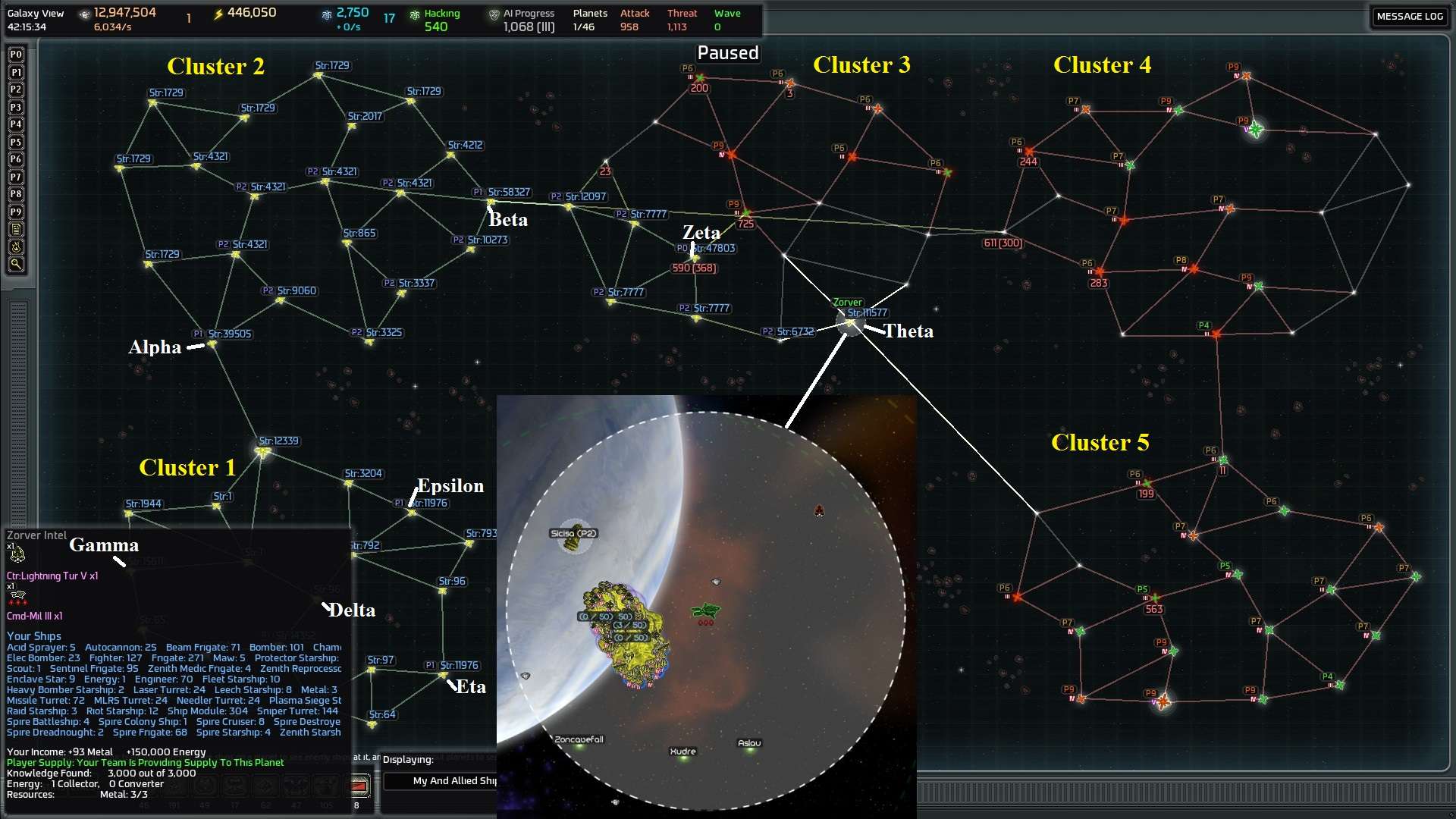
By 42.15.34 I was finally ready to build spire city Theta, after having smashed the latest 21k double-wave (9k AI1, 12k AI2) hitting Zeta a minute apart and rebuilding to full caps.
Zeta had a Lightning V turret controller, but there was no point in trying to protect it giving that the entire planet and spire city were sacrifices, so I did not even try. I built the spire city to level 2 with a habitation centre and five shard reactors, all in my default mixed defences configuration, and left it alone.
Shipyard City IotaNext up was the construction of spire city Iota at 42.27.54 back in cluster 2, a combined reactor/shipyard city.
Proof of Concept: Theta SacrificeThe next CPA came at 42:44, synchronizing with the exowave, and to my great pleasure it worked as I had planned: Theta was killed off by part of the exowave and the CPA while the other components of the exowave got killed at Beta by my fleet aided by the fixed defences.
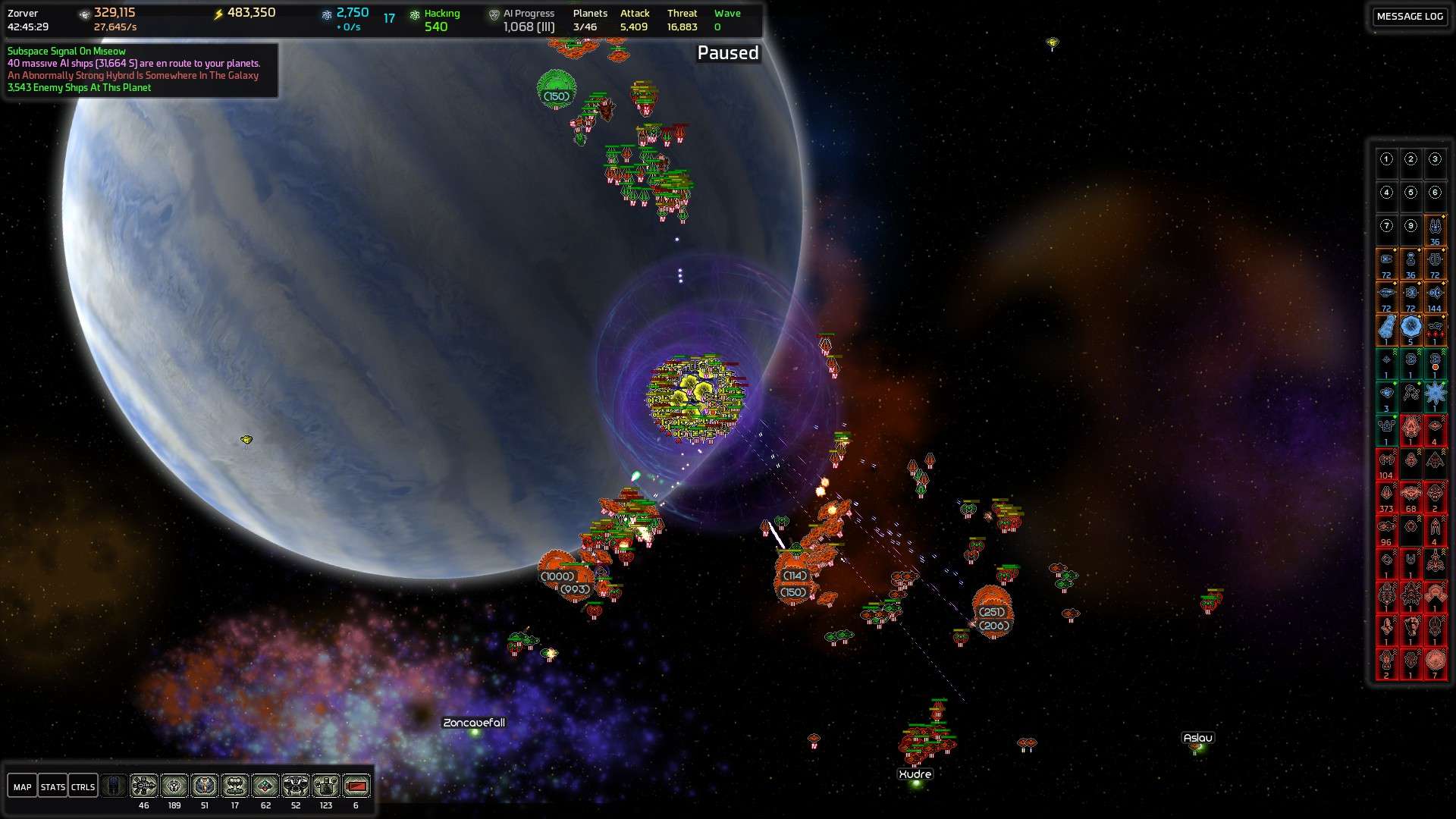
The survivors of the exowave that hit Theta then flew through the corridor of four logistics stations backed up by full caps of all Spider turrets and Sniper III turrets in each system (the stations themselves located as far from the route of travel as possible, to ensure they'd be out of range of anything without planet-wide range), and one or two ragged survivors finally arrived in Beta. Meanwhile, the CPA survivors (which were most of them) continued on the same route in order to reduce the planetary defences one by one, which made it trivial, once the exowave was dealt with and ship losses replaced, to send in the fleet to eradicate the CPS remnants – by then down to 11,000 or so.
It did take some time to recover after that, sending in rebuilders to the three logistics stations that had gotten overrun and, of course, the spire city in Theta had to be completely rebuilt, but if felt
much safer than the previous CPA.
The experience was proof that the concept worked, and worked well.
Sacrifice City KappaWith the concept vindicated and needing a lot more reactors to afford enough shipyards to gain the third Dreadnought, I chose Mictinhas, the planet that led the AI waves to Losuobi when that was my tanking planet, and a planet that was exactly three jumps away from both Beta and Zeta, to be the second sacrifice. Construction started at 43.24.06.
Unfortunately, Kappa could only be built to level 1 (for now) as it was adjacent to Dinkin, which as the alert reader will recall held an ARS as well as Experimental Engineers and Plasma starship fabricators... and four counterattack IV posts.
Kappa thus became my tenth city, and I was allowed to build a second Galactic Capitol, the bureaucrats manning the Big Gun having outgrown the original building, or something like that. Whatever the reason, the answer was obvious: put the second capitol in Beta as well.
Shipyard City LambdaShipyard Lambda got the remaining spot in cluster 2 at 43.37.02, and once it finished construction I was finally able to get my third Dreadnought!
PlanningIt struck me that it might be a good time to rethink my plans. The exowaves were becoming worryingly large with my eleven spire cities and two galactic capitols, and I occasionally had to resort to a warhead to keep things under control. Did I
really want to build another three cities to gain the fourth Dreadnought, when in order to do so two of the cities would have to be built in clusters 4 or 5?
The less space remaining to the special forces, the harder it would be to bypass them or lead them astray, and tough as the three Dreadnoughts, six Battleships, 24 Cruisers, and 100 Frigates of the spire fleet were, they wouldn't stand a chance in an open fight against the special forces, now numbering in excess of a hundred and sixty thousand ships, and given that the special forces featured copious numbers of Spire Gravity Drainers, any fight with them would by necessity end up as an open fight – kiting them in huge circles while killing them would not be an option.
With a heavy heart I shelved my plans for conquest. Eleven cities would just have to do. I really did want to approach this as a conquest game, I really, truly, did, but the risk management was getting out of hand.
On the positive side, having to kill every regular wave by hand was getting excruciatingly and mind-numbingly boring, so stopping conquest and moving into the endgame would provide me with an end to the game before too long, one way or the other.
Since I was not going the full conquest route, building a larger spire fleet, I decided that I would pursue the spire shard option to gain direct spire support.
First I would have to knock out the remaining core-A shield network, two of which were located with ARS's in cluster 2 and one with an ARS in cluster 4.
Timing is EverythingThe first step hinged on timing. Last time I had ventured into Dinkin, one of the ARS' planets in cluster 3, it took the special forces several minutes to arrive. Now, I didn't want to fight the special forces, and wiping out the four counterattack posts and then the command station before they arrived was a possibility, but I dearly wanted to get the Experimental Engineers for quicker repairs and construction. I was using my marks 1 and 2 of engineers to construct ships back at Gamma and mark 3 as the roving engineers, to be applied wherever the current need was. Having the Experimental Engineers as another roving patrol defaulting to helping with ship construction would significantly aid me in rebuilding my fleets and cities after waves.
My increase in AIP since the last hack meant that hacking was a realistic option. 1093 AIP (total 1459 earned) and 565 balance resulted in a hacking response of 293.
Well, I had unlocked Scout Starships I-IV and could arrange for complete vision of most of the paths used by the special forces, so the way forward was obvious: I did a dry-run, moving my fleet to Dinkin and measuring the time it took for the special forces to show up. At four minutes and 25-30 seconds it was not quite long enough to hack without interference, but so long as I was willing to accept casualties, sacrificing ships for time, it should be enough.
I retreated my ships out of the wormhole and waited for the special forces to return to their far haunts, after which I sent in the fleet and a hacker again, beginning a fabricator hack immediately,
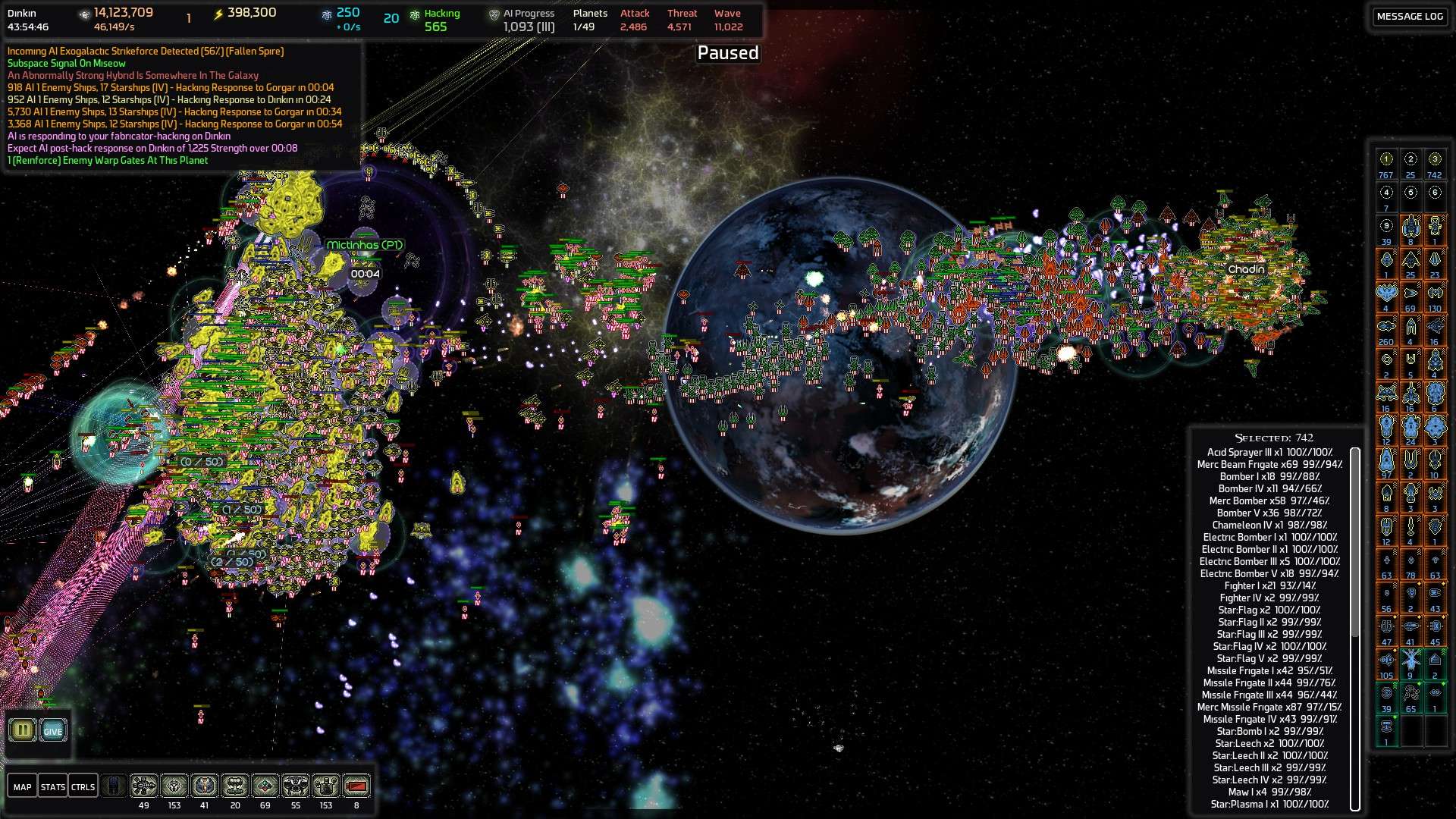
As expected, the special forces were not in time, though they did come rather too close for comfort. Immediately upon hack completion, the valorous Dreadnought fleet tucked tail and fled, losing a significant percentage of the fleet to the harrying attackers, but I had gained the Experimental Engineers and the Plasma V starship, which frankly was pretty much irrelevant by then considering the spire fleet. I had also gained a lot of hacking progress, my balance going from 565 to -5.
Hacking response for a future hack would be 2286 (only 1093 if not negative), meaning that I'd have to earn another 800 or so AIP for a hack to be done at a reasonable level, so this pretty much spelled the end of hacking – but then again, I had also accomplished pretty much everything I wanted.
It would be
nice to hack the remaining ARS' to choose their ship type, but except for one of them, the extra ships would not do a lot for me under the circumstances.
The one ARS that would have been nice to hack was the one on Dinkin, as its second choice was Munitions Boosters, but it was a choice between hacking the ARS and hacking the Engineers, and the Engineers were, by far, the most valuable for me at this point.
A marginal increase in combat power (given that I already had all Flagships marks I-V) versus 39 more teleporting engineers, each individually better at working than the mark 3's? It wasn't even a contest: I always focus strongly on logistics in strategy games.
Tedious Cleaning HouseThere'd been quite a few hacking reponse waves hitting Gorgar, spire city Zeta, and they leveled the place and spread out.
So they had to be stamped out.
Then I had to deal with two out of the three core-A shields, and I chose the one in Dinkin for its Bulletproof fighters, even though that meant destroying four counterattack posts. I did this only because they were the Special Forces Captain's posts. If the Mad Bomber had owned them, I'd have said to hell with it and gone for the third of the shields, skipping that ARS. There's no way I'd inflict the pain of dealing with four mark 4 Mad Bomber counterattack posts on myself if I could help it.
So the counterattacks had to be stamped out.
One thing with the other, cleaning up took me another hour or so, but by 45.08.05 when the next CPA announced 17,428 ships synchronized with 110 AI ships (145,841 S), the A network was down, I had all four marks of Bulletproof fighters, I could finally build sacrifice city Kappa up to level 2 (allowing me to shift a few reactors to shipyards in cluster 2), and the situation was under control.
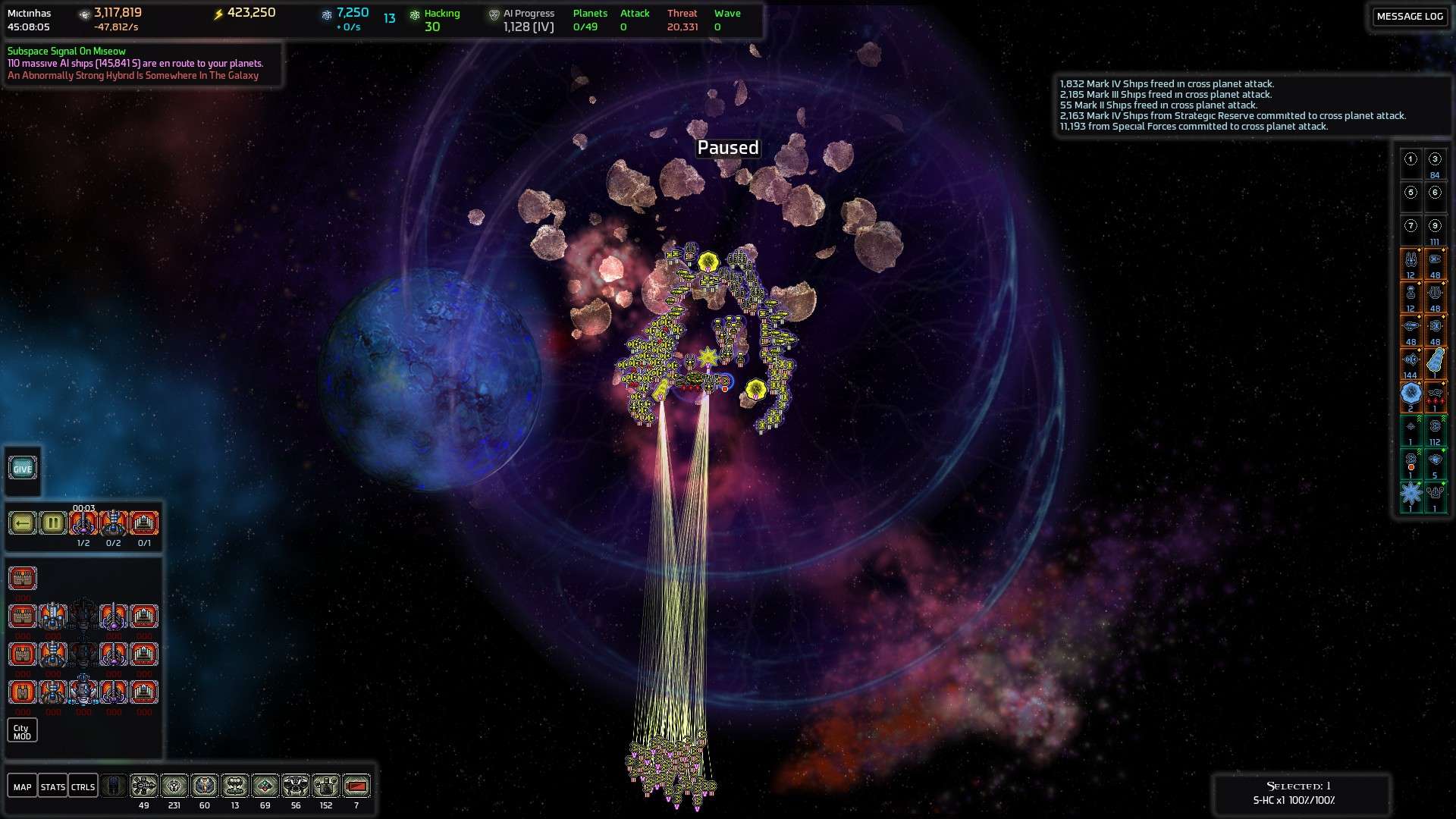 Onwards!
Onwards!Next, I blazed a path to the shard next to the Special Force's homeworld, burning the AI's command stations on the way to ensure a safe recovery.
When I say “next”, let it be understood that what I
really mean is something along the lines of “after yet another rebuilding, regular wave-crushing, etc etc period, I finally got to blaze that bloody path”. I also neutered a few more AI planets on general principles and as to allow me to get perfect vision of the special forces movement.
The shard would have to fly through neutral space for four warp jumps accompanied by the fleet in order to reach Theta, after which it should be home free, following my trail of logistics I stations the 11 jumps from Theta to the homeworld.
I made sure that the special forces were far away when I started, as they tend to be attracted to defend the AI's core worlds, and then began the survey.
It worked like a charm, and by 46:50:13 I was ready to build the Transceiver.
Now, the Transceiver flavour text said the AI would hit me with everything it had, and that even starting building it would make the AI go mad, so this strongly suggested that I would need my defences ready for a final fight the moment I began building. Since everything AI aggression connected so far to the FS story had meant that the AI would send exowaves, I chose to believe that to be the case here as well.
Primarily on the grounds that the AI hitting me with everything that it had would mean hitting me with the special forces, which was rather too scary to contemplate.
It was not clear to me from the information presented whether it would be a short and intense fight or a long fight of attrition, but since it was presented as an alternative to conquest and going to smash the home stations, it it was a war of attrition, it probably wouldn't be a question of hours, but of quarters of hours.
I had Fallen Spire exo on 73%, and the last CPA was at 45.08.05, which meant that I was due another CPA in the not so distant future. This argued in favour of waiting for both to occur.
On the other hand, I had just defeated two regular waves at spire city Zeta, had full metal (~18.2 million) and lots of salvage from Zeta, which counted in favour of getting on with the show now.
If I waited for the next CPA, I'd probably just find myself waiting for the next regular waves, and then waiting for the exo and then... No, It was time to end this.
The Final BattleI stripped spire city Zeta of all the uniques – all 22 forcefields, all mark IV and V turrets, all forts, and built them all over again in spire city Beta.
Amusingly enough, I forgot to lay out the minefields at first.
With 13 forts and 1 modfort supporting the HBCs, a full set of I-III turrets, all my mark IV and V turrets, all forcefields except mark 1 and 2 of mark 2, and a considerable arsenal of warheads, it was time to get on with the show: I would stop most attackers dead in Beta while not worrying too much if a few dozen ships got past, as my defence in depth of sniper and spider turrets would eat up most of them, and spire city Alpha would kill anything that managed to survive that.
(I left the Gravity Turret IIIs in tanking city Zeta – in case of a long fight there'd be regular waves hitting Zeta, and Zeta would fall – but with the turrets there it would take much longer, and probably, with the near synchronization of waves, the first wave from each AI would hit Zeta before it fell to either of them, meaning that it would take
two waves from one AI before an AI got to hit somewhere else with a wave – a random planet if it didn't move forth a warp gate guardian, Beta if it did).

6 Lighting III, 6 Lightning II, 5 Lightning I, 3 Armored III, 1 Armored II, 3 Armored I and 2 Nukes (just in case). A missile silo on the planet. Mark 3 and Experimental Engineers ready to repair and build new nukes, should it prove a drawn out fight. Call it one Lightning III produced per four minutes once the going got tough, to give some slack for Engineers to shift targets. (Armored III would take much more work).
It would have to do.
Having Alpha as a fallback position should Beta fall, I'd not be forced to sacrifice my fleet to hold it in a desperate last defence, but, if pressed by overwhelming odds with failure imminent, I could evacuate my fleet and nuke whatever remained in Beta while building forts in Alpha, assuming I had not drawn down my metal stocks during the fight. (Unlikely due to salvage, but not impossible depending on when the Beta command station died in that scenario).
46.58.50 the construction of the Transceiver completed and I got a 30 minute countdown. So it wasn't a fixed number of large waves, but a countdown, during which I'd undoubtedly be hit by exowaves.
So be it.
46.59.32, a mere 42 seconds later, the FS charge went from 73% to 100% and I got the message that 222 ships of 175,156 S would be arriving shortly.
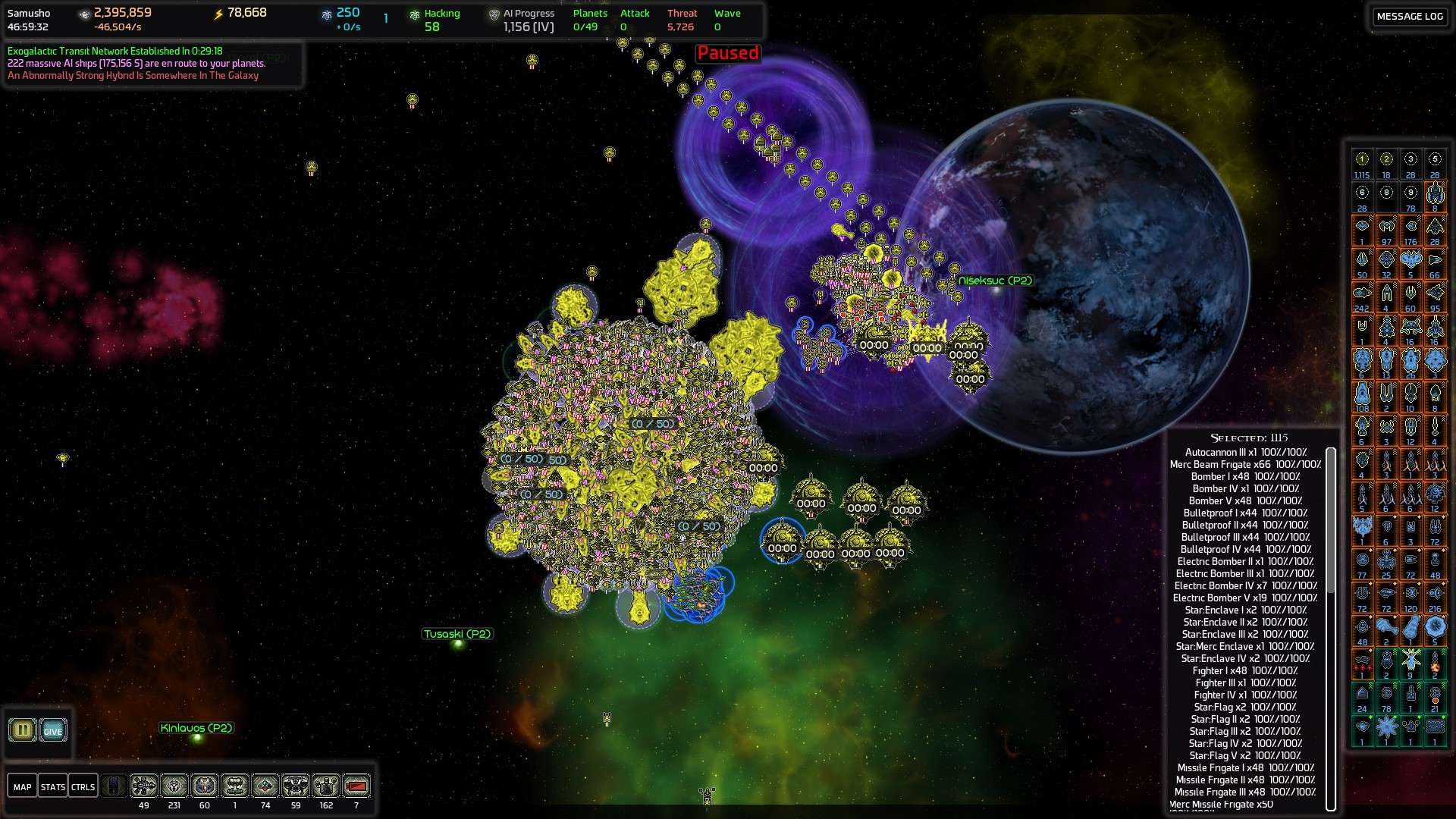
Some numbers are more important than others. Right at that point, the important number was 27%.
I won't say that it scared me shitless, but 27% charge in less than a minute? I hoped it was a one-time occurrence having to do with the construction of the Transceiver, because if that much strength spawned every three to four minutes for thirty minutes, I'd be in deep shit.
I decided to use warheads early, such that I'd get maximum time to produce new warheads, and to use them often rather than trying to see how little I could get away with. If waves were really every three to four minutes, there'd be precious little time to rebuild spire city beta between waves, which meant not allowing any of the spire city structures to be destroyed in the first place.

47.02.11, 12 AIP (1168 total), 2 minutes and 39 seconds later, most of the first wave had been destroyed. The rest swiftly followed. At most two-score vessels managed to fight their way to the next systems up the line, and they got killed by the fixed defences in depth through the next few systems they transited. To my considerable relief the next wave did NOT spawn within the next two minutes, giving me enough time to repair and rebuild the fleet.
47.08.19 the second FS exo declared, 216 ships (191,542 S). So while it was definitely not 27% per minute, it was still rather faster than before Transceiver construction, and it was larger than the first one. Destroying the major components of this wave took around three minutes and 11 AIP (1079 total), and there was a major breakout of about 170 vessels along the road road to Alpha, the most heavily defended route I had – five planets in a row fully defended by sniper and spider turrets of all marks. A single Hunter-Killer survived to reach Alpha, where it was unceremoniously shot dead upon arrival by the spire city's defences.
47.11.56 I got the message that the Mad Bomber would be sending a wave of 10,369 ships and 110 starships to tanking city Zeta.
47.17.10 the third FS exo declared, 208 ships (176,918 S), considerably less than the second exo, but I was not complaining. The Mad Bomber wave had arrived in Zeta and was two-thirds of the way to the station, slowly advancing while wiping out the Gravity turrets. It still had that last distance to go, and the turrets – including all the tractor turrets – to destroy before destroying the spire city and the station.
Four seconds later the next Special Forces Captain wave was announced for Zeta, and I breathed a sigh of relief – with only 11 minutes and 32 second to go on the countdown, these waves were the last ones I'd see before the countdown's end, and the tanking city had stayed alive long enough that both got directed to it rather than having one dumped
somewhere at random in an interior cluster.
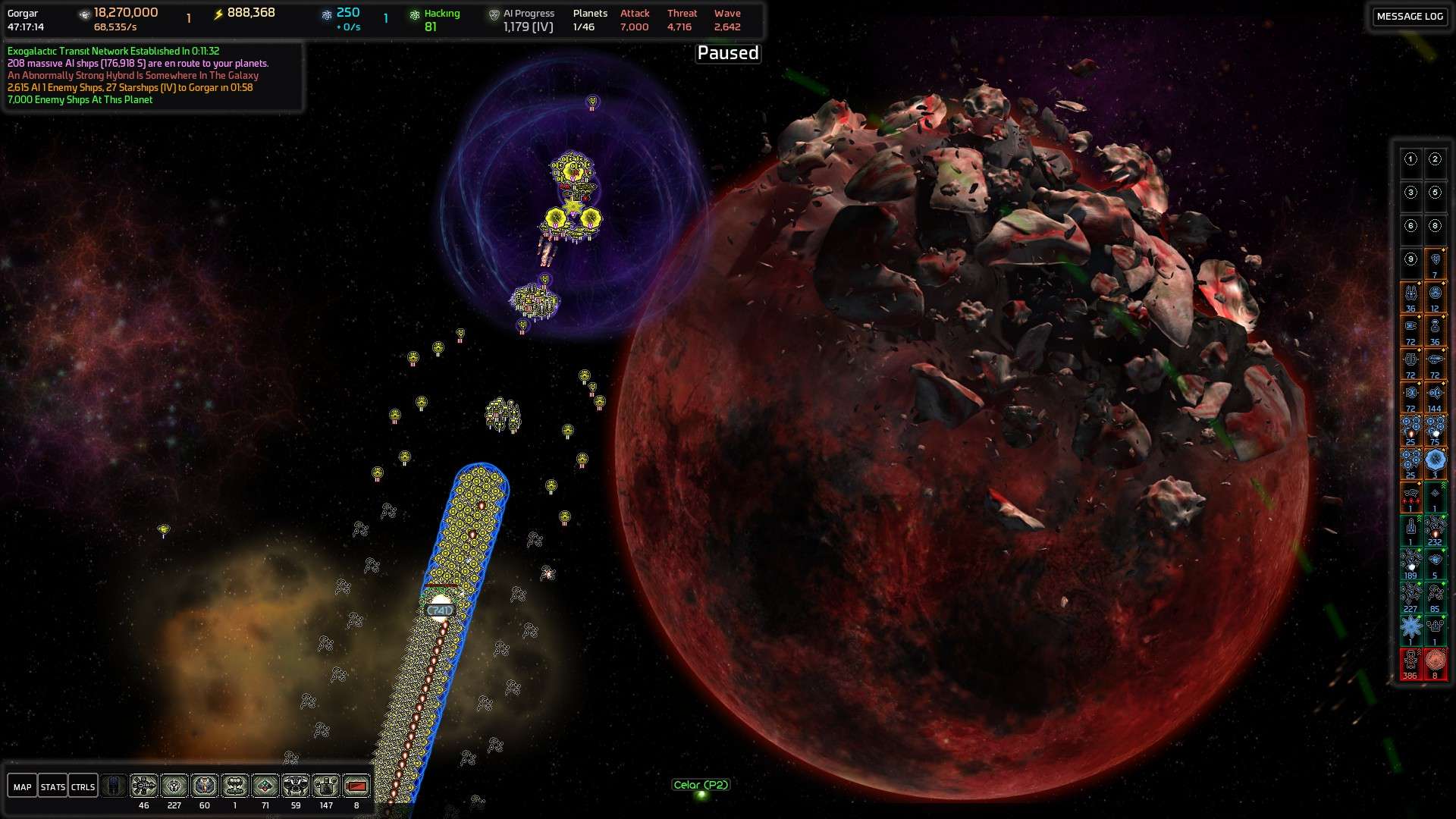
Despite its lesser strength, this wave hit my defences in Beta harder than the two previous ones. The loss of sacrifice city Theta and most of the logistic defenceposts leading to it during the first two waves resulted in more of the exo going directly for Beta, and it was soon felt. Sacrifice city Kappa still stood, having been left alone so far.
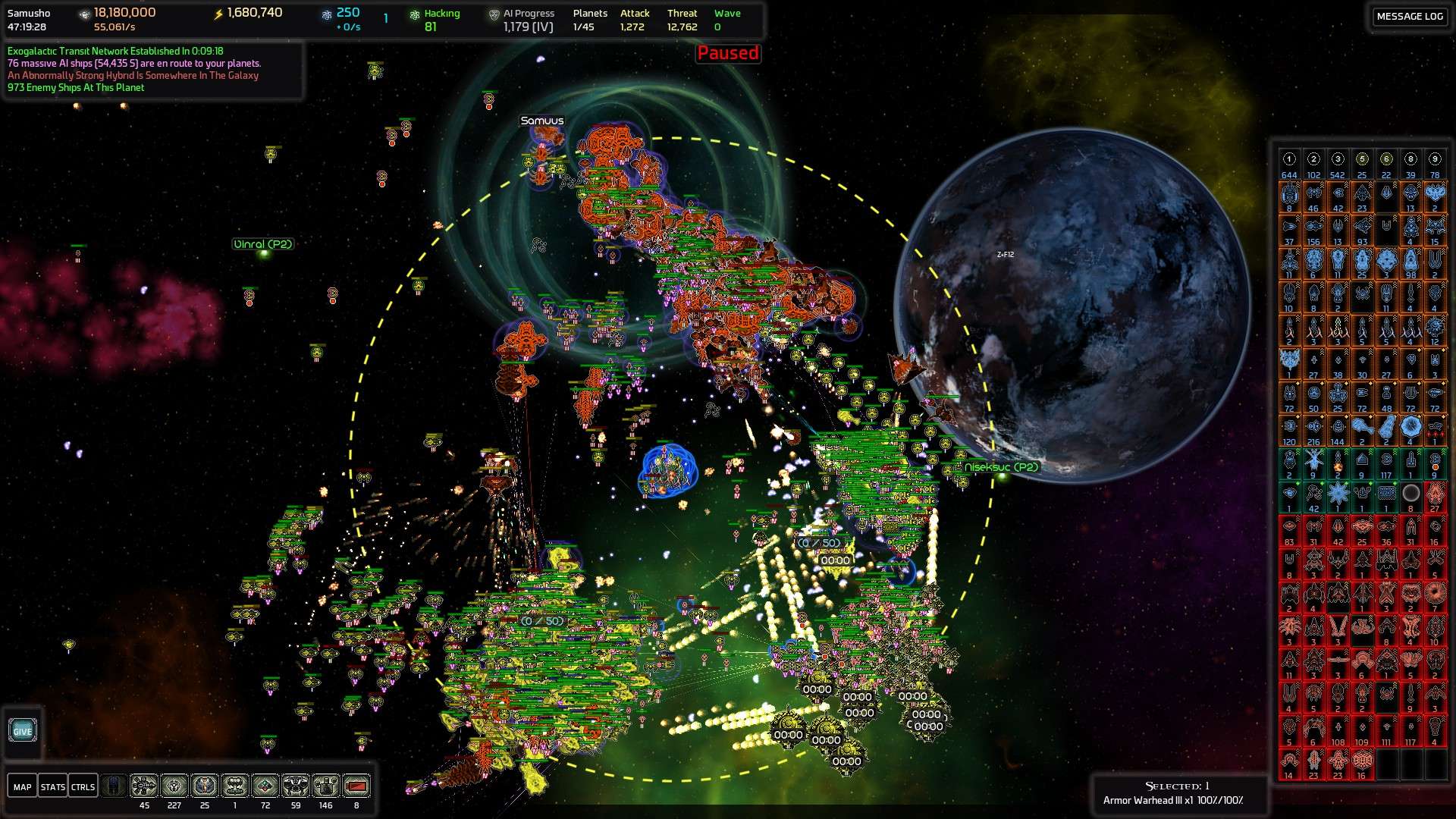
The third wave took slightly less than three minutes to deal with due to its intensity and cost 13 AIP (1192 total), as I subjected the fewer ships to more warheads. Only a handful of AI ships managed to make their ways to the next planets, where the fixed defences dispatched them readily.
The situation was under control and I could rebuild and recover from losses, but I sure was happy that I had stocked up on warheads before building the Transceiver. Without the ability to use them liberally, this tale would have been much bloodier.
With Zeta fallen, it made sense to build the mark 2 and 3 Gravity turrets that used to defend it, and which had so splendidly slowed down the first wave so the second also went there before the station fell, in Beta. I now set them up in grid covering all the AI's attack paths through Beta. They wouldn't help much, but every bit helped and they were available. The same went for the Zeta's tractor turrets and its minefields.
With some four minutes to go or so and the fourth exo nearly charged, the AI called a CPA. Given that it would activate far on the other side of the countdown, I couldn't care less. If that end of countdown was anywhere near as apocalyptic as had been hinted, another seventeen thousand ships for the AI's threatfleet would make little difference, and if it was not? Well, then I was in my most heavily defended taking spot so far with a stockpile of warheads.
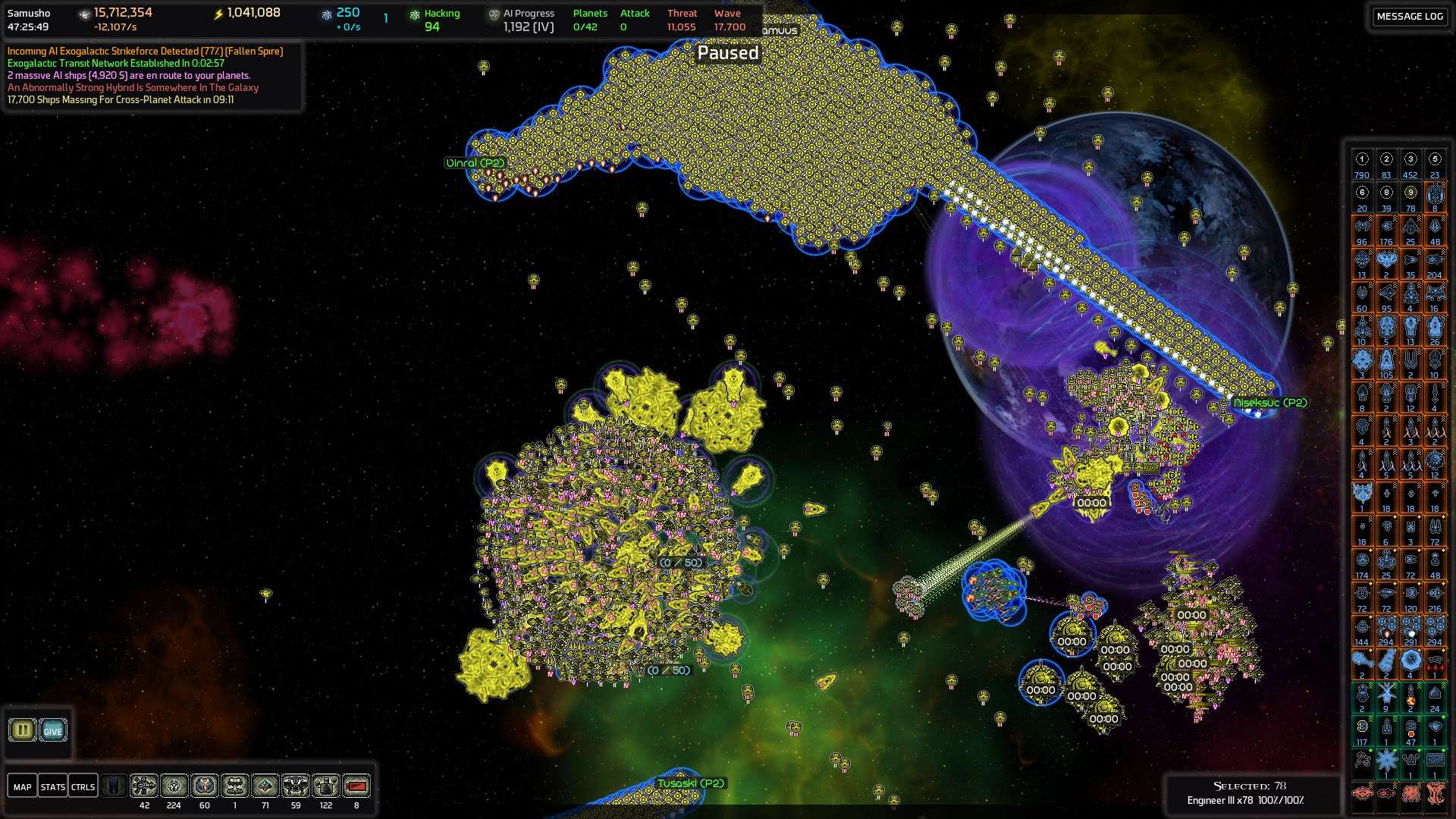
47.26.12 the fourth exo declared its arrival, 257 ships (185,540 S). The last exo wiped out my two remaining planets in cluster 3, including sacrifice city Kappa, and proceeded into Beta, but it was too late, too late.

The countdown completed and a spire fleet of considerable size spawned on my homeworld. 2 Superdreadnoughts, 18 Dreadnoughts, 63 Battleships, 304 Cruisers, 336 Destroyers, and 672 Frigates. Not only were the Superdreadnoughts much more powerful than the Dreadnoughts, every ship class did 16 times as much damage and had twice the hitpoints of the corresponding ships I had built, which felt rather like cheating to me, but was probably done for balance reasons to ensure their ability to deal with anything the AI could throw at them without having to provide them in their thousands.
I set down to watch the show, defending Beta from any incursions, while the spire split its fleet and went on the offensive. I was a bit concerned about that splitting, since formidable as it was, smaller detachments could conceivably be overwhelmed by the special forces, and where would I be then?
That said, it was a splendid feeling when the largest fraction of the fleet passed through Beta on the way to the AI territory!
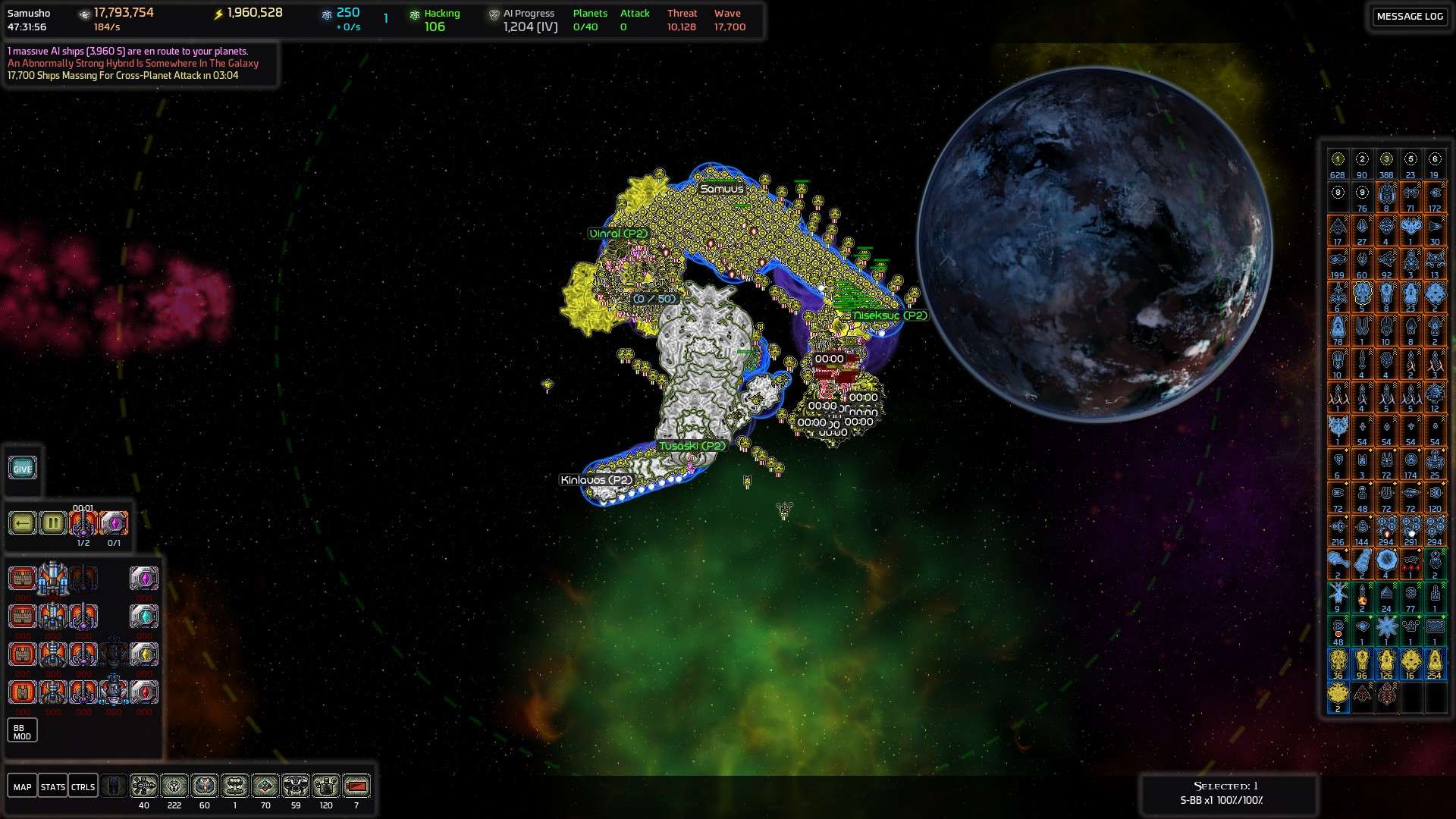
And an even better feeling when I looked at my homeworld to check if any ships lingered there to defeat it and saw that a second spire fleet had spawned. And some time later, a third.
I was no longer concerned about the AI managing to defeat the spire – since I had been able to hold it back on my own, there was no way a steady supply of spire reinforcements of that magnitude would fail to push back the AI, and should it ever devolve into a stalemate, which seemed extremely unlikely given the strength of the spire forces, I'd be able to intervene decisively with my fleet and warheads where it would tip the scales.
The only thing to worry about now was the possibility of the spire killing some of the remaining counterattack posts and sending waves to my homeworld or undefended planets nearby, but in that case I'd have several minutes warning to move major defences and my fleet there to help protect it, so I considered this only a small threat given the patrolling spire fleets.
Interestingly enough the Fallen Spire exo charge continued as wildly as it had done before, so the fifth wave spawn soon enough, but most of it got eaten up by roving spire fleets and only about a third of it reached Beta.
A few minutes later the first AI homeworld came under spire attack, and within two minutes the second was attacked by another fraction of the fleet, each led by a Superdreadnoughts. This triggered countdowns for undoubtedly nasty exo retaliation, but given that the AI only took some four minutes to kill each AI homeworld, this was of little import. My mark IV scouts provided a glorious view of the carnage.
47.38.35 victory was declared, just short of forty minutes since the Transceiver finished construction, and this tale, and this brutal long campaign, was finally at an end.
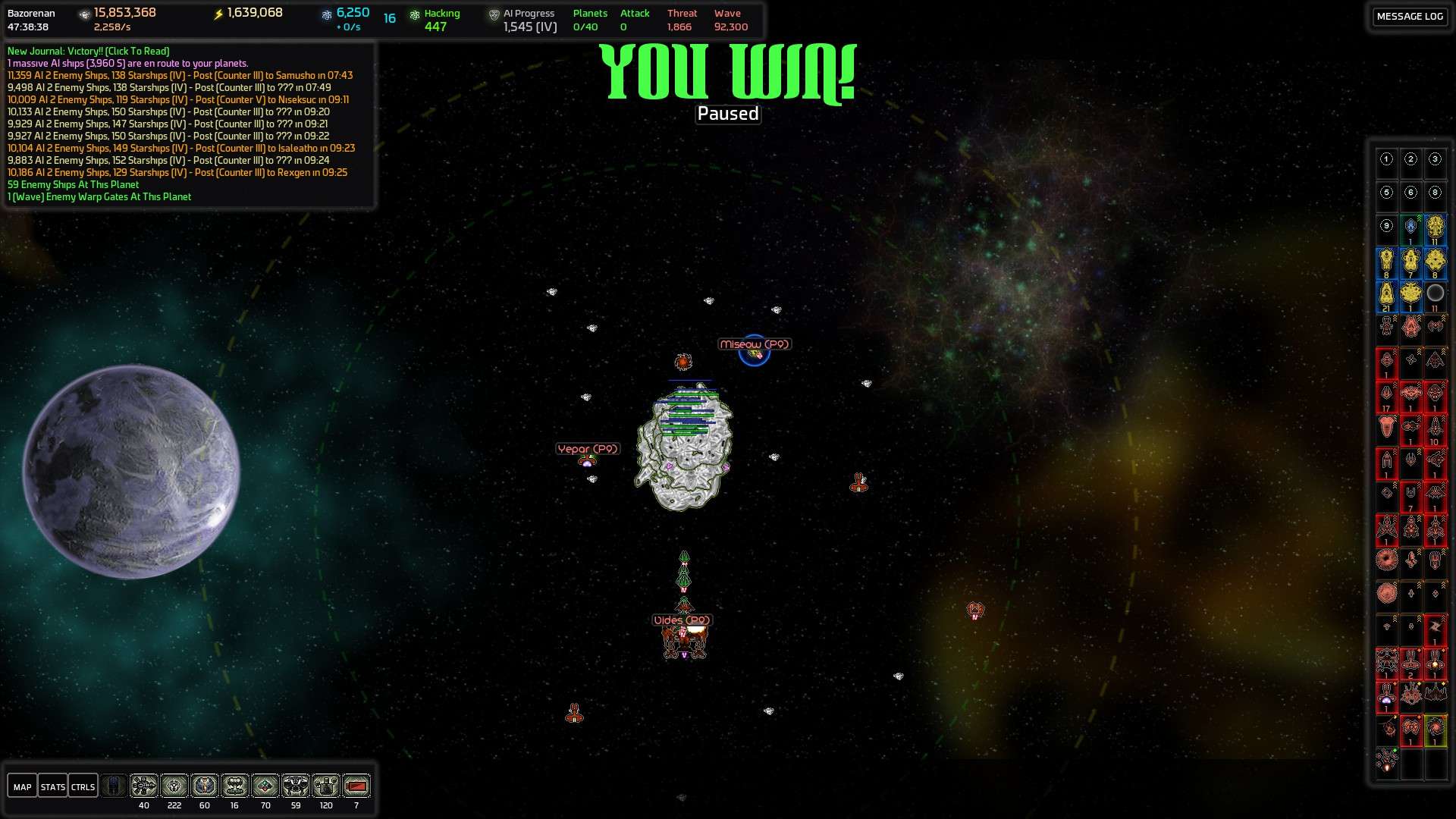
Those nine counterattacks, many with unknown desination? Yes, the AI got triggerhappy.
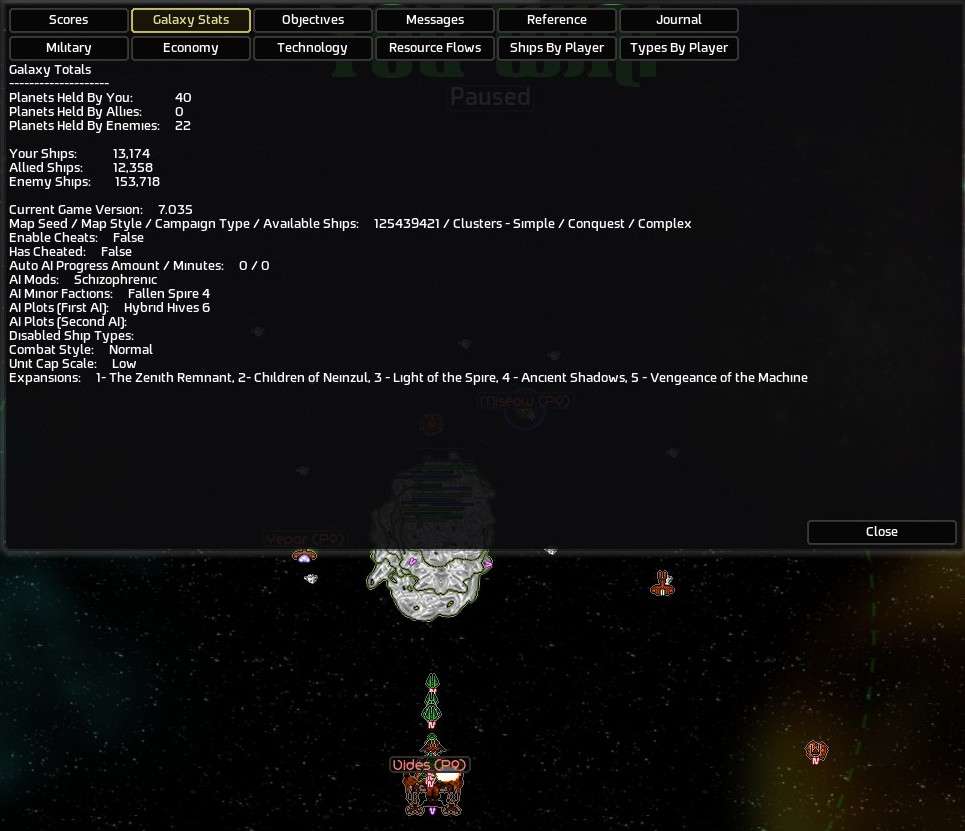
-----
Epilogue (rambling all over the place)You have been warned. These are my thoughts upon concluding the game, they are rambling, and I write them more to give my thoughts
shape and to aid my own recollections in the future of how I felt at this time as I do to inform anybody else, save perhaps Keith, who deserves a final status on his challenge.
If you read on, don't say you haven't been warned.
I learned a lot during this Fallen Spire game and am now confident of my mastering the basics of AI War, having played it as my primary game in the month and a half since I bought it. There is a lot left to learn, particularly with regards to
efficiently playing the game rather than solving most problems by brute force and patience, but those are the refinements that come automatically with time in any game once one has grasped the base mechanics.
There's no way a second FS game set up the same way would take nearly as long to win, but if I did set it up the same way using the same map or one as favourable for defences, and if I did go for a Transceiver victory, I feel confident of winning.
Not that I'd want to play a game with the same setup. There are a ton of options left untried, which gives the game great replayability: I have by no means mastered it all, only the corner labelled basic gameplay.
AI War – Fleet Command does not stand unrivalled, but I am pleased to say that it belongs amongst a very select group of strategy games that I did not feel certain within a week or two of purchasing of mastering in short order.
It took me nearly a week to get my first win on 7/7, learning the basics, and this 9/9 spire game took three, mastering those same basics and using spire fleets, and it would certainly have been lost several times without the experience gained in the handful of aborted spire attempts before chronicling this game, where I got to learn about hybrids and “funny” things like tackle drone launchers and lightning torpedo frigates. And even with all that knowledge, I
did lose once back in chapter 3 – a truly wonderous experience, though one that hit hard at the time.
As such, it is time to back off from AI War for a time to play other strategy games I have in my backlog. I seldom play the same game for a long time since most games are, when all is said and done, fairly simple once you grasp their basic mechanics, and most mechanics are fairly simple to learn or at least to grasp
enough that they can be manipulated by superior strategy. The great pleasure to me in playing strategy games against computer opponents is not so much in beating them as in
learning how the game works.
I will undoubtedly return for the next expansion and, as I predicted a month ago, on a regular basis every few months after that whenever the fancy strikes me for some AI War. Almost certainly with less extreme setups that will lead to victory or loss in less time. 46 hours is something that is hard to justify ripping out of the calendar, even during spring and summer with lots of mandated vacation.
Finally, I'd like to give a big thank-you to Keith for proposing this challenge, when I asked for game set-ups fit for my playing style. Despite my misgivings about going directly from 7/7 to 9/9 with dual-purpose AIs, you were entirely right: This was right up my alley after the initial modifications doing away with the 10/10 Hybrids and cross planet waves.
In the end it didn't become the conquest game I was expecting it to be, as at the largest extent before calling in the spire reinforcements I only controlled 49 and the AI 38 out of 100 planets, with the remaining 13 razed and outside the control of either functioning as a buffer of sorts, but it was great fun to drive the AIP up to tech four territory, to see how utterly incapable the defences from the basic game were for dealing with the regular waves at that AIP level at difficulty 9, and then crush them anyway.
On Specific Gameplay Elements (rambling part 2)Amusingly, I never unlocked Assault Transports, something I based on my first game had considered essential. As it turned out, when you are conquering almost all the real estate in your neighbourhood, there really is little point.
I loved the ability to defend in depth with turrets that came with the turret patch – it brought a lot of options of both strategic and logistic nature to the game.
The use of forts felt fairly ridiculous – those galaxy-wide caps seem well and truly designed for a more normal game. I fairly early reached a point where any further defensive knowledge unlocks would only aid single chokepoints and I had to put all forts in one or two locations to have them contribute meaningfully at all. Unlike forcefields, which work as cheap force multipliers by extending the life of other defences they defend, forts add linearly to defence.
Given that furthermore forts have a much higher ratio in both construction costs and energy per damageoutput that turrets have, while having a lower ratio of hitpoints/damageoutput, which is entirely unlike the HBCs that have the speciality of high damage and hitpoints at low cost, it is my strong belief the game would be better off (at least for all NON-minimum AIP games) with forts treated like turrets rather than forcefields or HBCs, getting per-planet caps rather than per-galaxy caps.
On energy costs – the current balance seems to work, at least for Fallen Spire games. A basic set of defensive turrets for a planet on the interior logistics roads in cluster 2 taken by the AI's exos was full caps of mark 3 needler turrets and marks 1-3 of spider and sniper turrets, for an energy expenditure of 240,000, meaning that each such lightly defended system was 90,000 in energy debt, while the sets of turrets for the defended logistics systems in cluster 3 had marks 1-3 of spider, sniper, and missile turrets, and marks 3 of needler, laser, MLRS, flak, and lightning, for an energy expenditure of 403,200 and an energy debt of 253,200.
Defending 7 such planets in cluster 3 and 8 in cluster 2 in addition to my chokepoint, tanking location, and fleets was a heavy strain on my energy finances, at the point of greatest extent requiring 101 active matter converters to support the 49 energy collectors 7 econ III stations, 7 econ II stations, and 6 econ I stations. It was really great that I had the option to build those defences, could in principle build them wherever I wanted, and still felt constrained in my actions having to carefully balance expenditures, if I wanted to ensure that I wasn't draining my resources so quickly that I might suddenly be out of luck with respects to repair or reconstruction, should the AI manage to take out the station on the system it was attacking and I was collecting salvage from.
While the cost of running the matter converters
was greater than my regular income from harvesters and stations, I attempted at all times to maintain a 20% of full metal-pool reserve and keeping my regular metal-income deficit below that needed to use half that reserve (so 10% of full pool) during a 2 minute station rebuilding salvage blackout. As always, mathematics was my friend, and this allowed me to keep on repairing and building through some of the most troubled times.
Regarding the Spire city buffs, I loved them too. The cities were now strong enough that they were respectable defenders without being dominant. Forts and turrets remained the primary source of defence, even in spire cities, but the spire cities contributed meaningfully to their own defence, something I did not at all feel in the attempt before the buff was introduced.
The special forces were, in a word, thoroughly ridiculous. If at any time up to and including during the Transceiver countdown they had decided to kill me, they could easily have done so. But then again, that's part and parcel with the what AI War is all about in the first place – the AI being preoccupied doing something else – so it is definitely not something to complain about. And they sure did scare me, the one time they unexpectedly went on the offensive and wiped out my tanking planet.
The final Transceiver countdown.... It felt like a bit of a letdown, to be honest. Those waves, being only marginally more powerful than the waves before I built the transceiver, never stood a chance against the forces I assembled to meet them in spire city Beta. Sure, I was at 11 spire cities then, and somebody building it after only 5 cities would have had a much smaller spire fleet to defend with, but then again, somebody at 5 cities would receive much smaller exos and the 13 forts, the full caps of turrets, and the spire city would have contributed exactly as much damageout to the system at 5 as at 11 cities (excepting only the single extra Galactic Capitol).
Unless experiences from people trying it out with only five cities are very dissimilar, I strongly suggest buffing the Transceiver waves, buffing their frequency or their power. (Or having building the Transceiver make the AI use the special forces as an attack fleet going straight for the homeworld, or perhaps just freeing it to act as normal threat. Why exactly is it using it to defensively patrol its territory at a time when the player is told that the AI is throwing everything at him? Send in the special forces for more fun! Worst case, people will just have to use nukes. Talk about making a killing.)
The spire fleet spawned at the end felt suitably majestic, though I would have liked it to not cause counterattack posts to spawn counterattacks against the player when destroyed by the spire. The fact that I was able to conceive of losing the game to the AI, even after the spire fleet arrived, if the spire were to destroy a couple of counterattack posts in a row with the counterattacks spawning near the homeworld, was sickening. In the event, as you can see from the victory screen, the spire did cause 92,300 ships worth of counterattack post waves on its way to kill the AI, it just happened not to matter because it killed off the AI before the waves could spawn. If it had taken longer about killing the AI, that would not have been the case, and the winner would have been determined by the randomly chosen wave targets and the location of spire fleets at the time of wave spawning. I'd have been able to nuke two of them, so there was some leeway, but still. NOT COMFORTING. Then again, this is arguably less of an issue now, since a patch after I started the game had the great change that made counterattack posts optional.
Hacking... I ended up doing a lot of hacking, and would have been able to do a lot more if I had spread it over more different topics rather than engage primarily in fabricator hacking. On the positive side, after the hacking patch, hacking felt relevant almost to the end, it only really ended being a relevant option when I sank myself by the double Engineer/Plasma hack, that wiped out my remaining 565 HaP and put me at greater than 1300 AI response, at which point I'd have to wipe out more AI planets than were left in the game to reduce it enough to make hacking viable again - but it was worth it!
So overall for this game, I liked how it worked out. I didn't get everything I wanted, I had to prioritize, but I conquered a lot, which allowed me to hack a lot.
ConclusionIn conclusion, I had a blast, and I thank Christopher and Keith for a great game, Pablo for excellent music, and the graphics artists for delivering clear and functional graphics. You've known it for years, but now I too know that you've made a real gem of a strategy game.
If I have any niggles, it is that I'd have liked an even greater focus on logistics, as logistics is what's
hard, but then, I almost always feel that way about strategy games and it is not always appropriate given the overall game-flow. Sometimes simplicity is preferable.